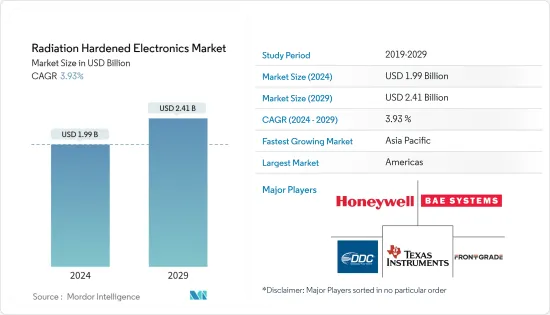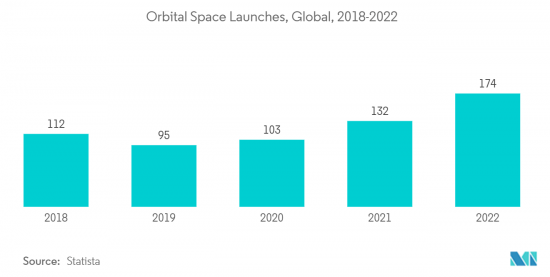 |
市场调查报告书
商品编码
1405716
抗辐射电子产品:市场占有率分析、产业趋势/统计、成长预测,2024-2029Radiation Hardened Electronics - Market Share Analysis, Industry Trends & Statistics, Growth Forecasts 2024 - 2029 |
||||||
※ 本网页内容可能与最新版本有所差异。详细情况请与我们联繫。
2024 年耐辐射电子市场价值为 18.1 亿美元,预计到 2029 年将达到 21.8 亿美元,预测期内复合年增长率为 3.87%。

抗辐射电子产品旨在承受极端辐射,用于情报、监视和侦察 (ISR) 系统。对监视、资讯收集和边境管制等安全措施的需求不断增长,推动了对抗辐射电子设备的需求。面对高辐射水平的挑战,抗辐射材料需要适当的电源管理。电子设备损坏可能会导致安全隐患。因此,这些设施需要可靠、抗辐射的电源管理系统。
随着我们更多地依赖卫星导航和其他基于卫星的应用,卫星发射和其他太空任务的数量在全球范围内不断增加。为了确保卫星上嵌入式系统的正常运行,对抗辐射电子产品的需求预计将会激增。
有限的可得性和性能限制阻碍了即时成像、国防和太空市场中的 5G/6G通讯以及核融合和 SMR 的抗辐射电子装置对高性能半导体的需求。儘管该行业有显着的成长动力,但组件可得性不足仍然是该行业面临的挑战。
然而,为了模拟太空工作环境,设计抗辐射电子测试台是很复杂的,因为需要考虑一些意想不到的因素来测试性能和可靠性,以下是步骤。随着技术的进步和抗辐射电子产品的应用扩展,新应用的广泛研究和开发的成本变得明显更高,而且盈利和回报率更低。
抗辐射电子市场趋势
预测期内空间应用引领市场
人造卫星有多种应用,包括通讯、定位服务和地球观测。自 1957 年人造卫星发射以来,天基任务经历了巨大的成长。卫星已发展成为民用和国防部门科学研究的首选。对卫星不断增长的需求促使卫星製造商采用具有成本效益的方法来大规模生产卫星。
越来越多的太空应用正在推动用于各种任务的抗辐射和抗辐射电子设备的创新,包括讯号处理、数位转换、电源管理控制和固体资料储存。革命性的技术进步促进了电子产品的小型化,并推动了智慧材料的发明。因此,卫星的尺寸和品质会随着时间的推移而减小,这对製造商来说是有利的。在涉及小型卫星的计划机会的推动下,许多航太巨头也在这一领域进行投资。例如,2023 年 9 月,Efficient Power Conversion Corporation (EPC) 推出了用于高可靠性和太空应用的氮化镓 GaN场效电晶体。 DCDC 电源转换器、马达驱动器、雷射雷达、深探针和空间离子推进器等应用都受益于这些设备的性能和快速部署。它特别适用于低地球轨道(LEO)、地球同步轨道 (GEO) 和航空电子系统。由于辐射屏蔽是空间电子产品的关键设计元素,因此此类发展预计将推动对抗辐射电子产品的需求。

预计北美地区在预测期内将产生最高的需求
由于技术创新和大量最终用户(主要在美国)的存在,预计北美将在预测期内主导抗辐射电子市场。美国是基于卫星的远端检测和通讯系统的狂热用户,推动了北美对抗辐射电子产品的需求。此外,该地区是多家知名电子製造公司的所在地,拥有强大的研发和製造基础设施,为该地区引人注目的市场的持续成长做出了贡献。美国是航太和国防应用领域的领导者,网路中心战技术的快速采用预计将在预测期内增强该特色市场的成长前景。
电子产业的辐射耐受特性概述
抗辐射电子市场适度分散。抗辐射电子市场的主要企业包括 Analog Devices、 资料 Devices、Microchip Technology、Renesas Electronics 和 IBM。电子製造业竞争激烈,随着全球战场环境的演变和应用的多样化,企业必须根据最终用户不断变化的需求调整产品系列。该市场也受到旨在增强现役军事资产能力的升级合约分散的显着影响。为了赢得长期合约并增加市场占有率,参与者正在大力投资于复杂产品的研发。
其他福利:
- Excel 格式的市场预测 (ME) 表
- 3 个月分析师支持
目录
第一章简介
- 调查先决条件
- 调查范围
第二章调查方法
第三章执行摘要
第四章市场动态
- 市场概况
- 市场驱动因素
- 市场抑制因素
- 产业吸引力-波特五力分析
- 供应商的议价能力
- 买家/消费者的议价能力
- 新进入者的威胁
- 替代品的威胁
- 竞争公司之间敌对关係的强度
第五章市场区隔
- 目的
- 宇宙
- 航太/国防
- 核能发电厂
- 成分
- 微处理器
- FPGA
- 记忆
- 感应器
- 地区
- 北美洲
- 美国
- 加拿大
- 欧洲
- 英国
- 法国
- 德国
- 义大利
- 俄罗斯
- 其他欧洲国家
- 亚太地区
- 中国
- 印度
- 日本
- 韩国
- 其他亚太地区
- 拉丁美洲
- 巴西
- 墨西哥
- 其他拉丁美洲
- 中东/非洲
- 阿拉伯聯合大公国
- 沙乌地阿拉伯
- 埃及
- 南非
- 其他中东/非洲
- 北美洲
第六章竞争形势
- 供应商市场占有率
- 公司简介
- Analog Devices, Inc.
- BAE Systems plc
- Cobham Limited
- Data Device Corporation
- Honeywell International Inc.
- IBM Corporation
- Infineon Technologies AG
- Microchip Technology Inc.
- Micropac Industries, Inc.
- Renesas Electronics Corporation
- Solid State Devices, Inc.
- STMicroelectronics International NV
- Texas Instruments(TI)
- Advanced Micro Devices, Inc.
- General Dynamics Corporation
第七章 市场机会及未来趋势

The Radiation-Hardened Electronics Market is valued at USD 1.81 billion in 2024 and is expected to reach USD 2.18 billion by 2029, registering a CAGR of 3.87% during the forecast period.
Radiation-hardened electronics are used for Intelligence, surveillance, and reconnaissance (ISR) systems, as they are built to survive extreme radiation exposures. The rise in demand for security measures such as monitoring, information collection, and border control is going to fuel the demand for radiation-hardened electronics. In the challenging situation of high radiation levels, radiation-hardened materials require proper power management. Any damage to electronics might lead to safety hazards. Thus, these facilities require reliable radiation-hardened power management systems.
Increased dependence on satellite navigation and other satellite-based applications increased the number of satellite launches and other space missions undertaken on a global level. It is expected to create a demand surge for radiation-hardened electronics to ensure the proper functioning of embedded systems onboard the satellites.
The demand for high-performance semiconductors for real-time imaging, 5G/6G communication in defense and space markets, and high radiation-tolerant electronics for nuclear fusion and SMRs is hindered because of limited availability and performance restrictions. While there are major growth drivers in this area, the availability of parts is scarce and thus poses a challenge for the sector.
However, designing a radiation-hardened electronic test bed is a complex procedure, as the simulation of the space-based working environment requires consideration of several unforeseen factors to test for performance and reliability. With the advancement of technology and the proliferation of applications of radiation-hardened electronics, the cost of conducting extensive R&D for emerging applications is significantly higher and fails to ensure profitability and returns.
Radiation Hardened Electronics Market Trends
Space Application to Lead the Market in The Forecast Period
Satellites are used for a plethora of applications, such as communications, positioning services, and Earth observation. Since the launch of Sputnik in 1957, space-based missions witnessed tremendous growth. It is evident through the construction of the International Space Station and the launch of more than 8,100 space objects, including dozens of exploration missions to every corner of the Solar System. Satellites evolved as the preferential choice for conducting scientific research by the commercial and defense sectors. The increasing demand for satellites encouraged satellite manufacturers to inculcate cost-effective approaches for large-scale production of satellites.
Innovation in radiation-tolerant and radiation-hardened electronics for a variety of tasks ranging from signal processing, digital conversion, power management controls, and solid-state data storage is driven by the increasing number of space applications. Revolutionary technological advancements facilitated the miniaturization of electronics, which pushed the invention of smart materials. It, in turn, reduces the satellite size and mass over time for manufacturers. Driven by the opportunities in the projects involving small satellites, many aerospace giants are also investing in this sector. For instance, in September 2023, Efficient Power Conversion Corporation, EPC, introduced gallium nitride GaN field effect transistors for high reliability and space applications. DCDC power converters, motor drives, lidars, deep probes, and ion thrusters for space applications are applications that benefit from the performance and rapid deployment of these devices. They are particularly suited to Earth orbit satellites with a Low Earth Orbit (LEO), Geosynchronous Earth Orbit (GEO), and Avionics systems. Such developments are anticipated to drive the demand for radiation-hardened electronics, as radiation shielding is a critical design aspect for electronic components for space-based applications.

The North America Region is Expected to Generate the Highest Demand During the Forecast Period
North America is anticipated to dominate the radiation-hardened electronics market during the forecast period, fostered by technological innovations and the presence of a large number of end users, particularly in the US. The US is an avid user of satellite-based telemetry and communication systems, driving the demand for radiation-hardened electronics in North America. An existing robust R&D and manufacturing infrastructure, marked by the presence of several prominent electronics manufacturing companies in the region, also contributed to the persistent growth of the market in focus witnessed in the region. The US is a frontrunner in aerospace and defense applications, and the rapid adoption of network-centric warfare techniques is anticipated to bolster the growth prospects of the market in focus during the forecast period. For instance, the US Air Force awarded a USD 222.6 million contract to General Dynamics Mission Systems for secure and radiation-hardened communications systems. As per the contract, General Dynamics will deliver high-altitude electromagnetic pulse and radiation-hardened general area alerting, ultra-high frequency line-of-sight communications to aircraft.
Radiation Hardened Electronics Industry Overview
Radiation-Hardened Electronics market is moderately fragmented. The prominent players in the radiation-hardened electronics market are Analog Devices, Inc., Data Device Corporation, Microchip Technology Inc., Renesas Electronics Corporation, and IBM Corporation, among others. The electronics manufacturing industry is highly competitive, and with the evolving global battlefield environment and diversification of applications, companies must align their product portfolios to the evolving requirements of end users. The market is also significantly influenced by the dispersion of upgrade contracts to enhance the capabilities of the current fleet of active military assets. In order to gain long-term contracts and enhance their market share, players are investing significantly in the R&D of sophisticated product offerings.
Furthermore, continuous R&D is fostering technological advancements in platforms and associated products and solutions of the active players in the radiation-hardened electronics market. For instance, in April 2023, Coherent Logix offered a HyperX line of radiation-hardened software-defined microprocessors. HyperX's space processors are fully programmable software-defined platforms for video imaging, AI, communications, and adaptive processing on the satellite with Software Defined Networking or Active Cyber Security. Coherent Logix's latest offering is HyperX: Midnight system-on-chip (SoC) processor for space applications.
Additional Benefits:
- The market estimate (ME) sheet in Excel format
- 3 months of analyst support
TABLE OF CONTENTS
1 INTRODUCTION
- 1.1 Study Assumptions
- 1.2 Scope of the Study
2 RESEARCH METHODOLOGY
3 EXECUTIVE SUMMARY
4 MARKET DYNAMICS
- 4.1 Market Overview
- 4.2 Market Drivers
- 4.3 Market Restraints
- 4.4 Industry Attractiveness - Porter's Five Forces Analysis
- 4.4.1 Bargaining Power of Suppliers
- 4.4.2 Bargaining Power of Buyers/Consumers
- 4.4.3 Threat of New Entrants
- 4.4.4 Threat of Substitute Products
- 4.4.5 Intensity of Competitive Rivalry
5 MARKET SEGMENTATION
- 5.1 Application
- 5.1.1 Space
- 5.1.2 Aerospace and Defense
- 5.1.3 Nuclear Power Plants
- 5.2 Component
- 5.2.1 Microprocessor
- 5.2.2 FPGA
- 5.2.3 Memory
- 5.2.4 Sensors
- 5.3 Geography
- 5.3.1 North America
- 5.3.1.1 United States
- 5.3.1.2 Canada
- 5.3.2 Europe
- 5.3.2.1 United Kingdom
- 5.3.2.2 France
- 5.3.2.3 Germany
- 5.3.2.4 Italy
- 5.3.2.5 Russia
- 5.3.2.6 Rest of Europe
- 5.3.3 Asia-Pacific
- 5.3.3.1 China
- 5.3.3.2 India
- 5.3.3.3 Japan
- 5.3.3.4 South Korea
- 5.3.3.5 Rest of Asia-Pacific
- 5.3.4 Latin America
- 5.3.4.1 Brazil
- 5.3.4.2 Mexico
- 5.3.4.3 Rest of Latin America
- 5.3.5 Middle-East and Africa
- 5.3.5.1 United Arab Emirates
- 5.3.5.2 Saudi Arabia
- 5.3.5.3 Egypt
- 5.3.5.4 South Africa
- 5.3.5.5 Rest of Middle-East and Africa
- 5.3.1 North America
6 COMPETITIVE LANDSCAPE
- 6.1 Vendor Market Share
- 6.2 Company Profiles
- 6.2.1 Analog Devices, Inc.
- 6.2.2 BAE Systems plc
- 6.2.3 Cobham Limited
- 6.2.4 Data Device Corporation
- 6.2.5 Honeywell International Inc.
- 6.2.6 IBM Corporation
- 6.2.7 Infineon Technologies AG
- 6.2.8 Microchip Technology Inc.
- 6.2.9 Micropac Industries, Inc.
- 6.2.10 Renesas Electronics Corporation
- 6.2.11 Solid State Devices, Inc.
- 6.2.12 STMicroelectronics International N.V.
- 6.2.13 Texas Instruments (TI)
- 6.2.14 Advanced Micro Devices, Inc.
- 6.2.15 General Dynamics Corporation













